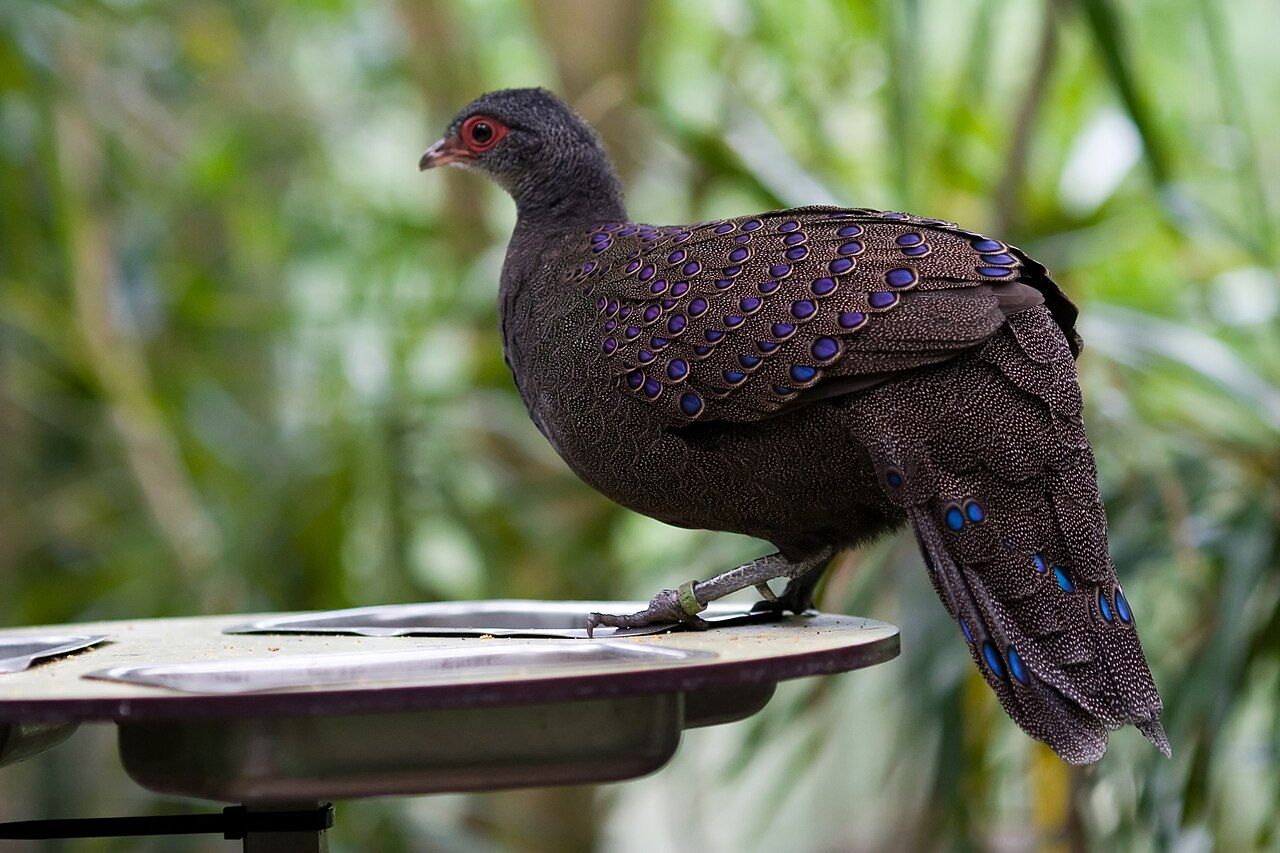
The 10 + Most Beautiful Birds in the World
The 10 + Most Beautiful Birds in the World
✅ Checked by Roohi.
It’s time for you to feast your eyes on some of the most gorgeous feathered creatures on the planet. We’re not just talking colorful plumage here – though there’s plenty of that. These birds have an almost magical beauty about them that goes beyond their looks. Get ready to meet 10 birds so striking you won’t believe nature dreamed them up. From tropical stunners to the avian supermodels of the Arctic, you’ll discover birds with designs so intricate and colours so vivid, they seem more like works of art than wildlife. So find a comfy spot to settle in and prepare to have your breath taken away by some of the world’s most beautiful birds.
Criteria For Ranking: Factors That Define Beauty In Birds
When it comes to beautiful birds, there are a few qualities that make them stand out from the flock. When ranking the most beautiful birds of the world, several factors come into play to determine their aesthetic appeal. Firstly, plumage plays a crucial role, as vibrant and striking colors are often associated with beauty in birds. The intensity and combination of hues, patterns, and iridescence contribute significantly to their overall attractiveness. Secondly, the shape and size of a bird also influence its beauty; elegant postures or unique body structures can captivate observers.
Additionally, distinctive features such as crests, beaks, tails, or ornaments further enhance their charm. Furthermore, courtship displays and vocalizations exhibit the gracefulness and complexity of mating rituals in certain bird species. Lastly, rarity can also add to a bird’s allure as it arouses fascination and curiosity among bird enthusiasts.
Ornate Plumage
Elaborate plumage—including elongated tail feathers, ruffled crests on their heads, and other decorative feathers—adds to a bird’s allure. Birds of paradise are well-known for their flamboyant plumes used in mating displays. The male King of Saxony bird of paradise has two ribbon-like feathers that are almost twice the length of its body! Peafowl, with their iridescent green-blue necks and long trained tail feathers, are also stunning specimens.
Vibrant Colours
Many of the world’s most stunning birds are adorned in vibrant colors and striking patterns. Birds like the rainbow lorikeet of Australia, the golden pheasant of China, and the resplendent quetzal of Central America are prime examples. Their dazzling blues, greens, reds and golds are a sight to behold. Some birds even have iridescent feathers that seem to change color when they move and catch the light.
Rarity
Some birds become all the more striking and sought after due to their rarity in the wild. Birds like the Andean cock-of-the-rock, the kakapo of New Zealand, and the Philippine eagle are difficult to spot in their native habitats, making any sighting a special treat. Their scarcity also highlights how precious they are, and how important conservation efforts are to protecting these beautiful creatures for generations to come.
In the end, beauty is certainly in the eye of the beholder. But when it comes to birds, a dazzling display of colors and feathers, coupled with a mysterious air of rarity, create a vision of loveliness that most anyone can appreciate. The world would be a little less bright without these feathered jewels.
Top 10: A Countdown Of The Most Stunning Avian Species
Birds, with their vibrant plumage and graceful flight, have captivated humans for centuries. Here, we present a countdown of the top 10 most stunning avian species that showcase nature’s artistic prowess.
#15. Rainbow Lorikeet: A Living Kaleidoscope
- Scientific Name: Trichoglossus haematodus
- Habitat: Australia and Southeast Asia
- Notable Features: Dazzling blues, greens, reds, and golds; known for vibrant and varied coloration.
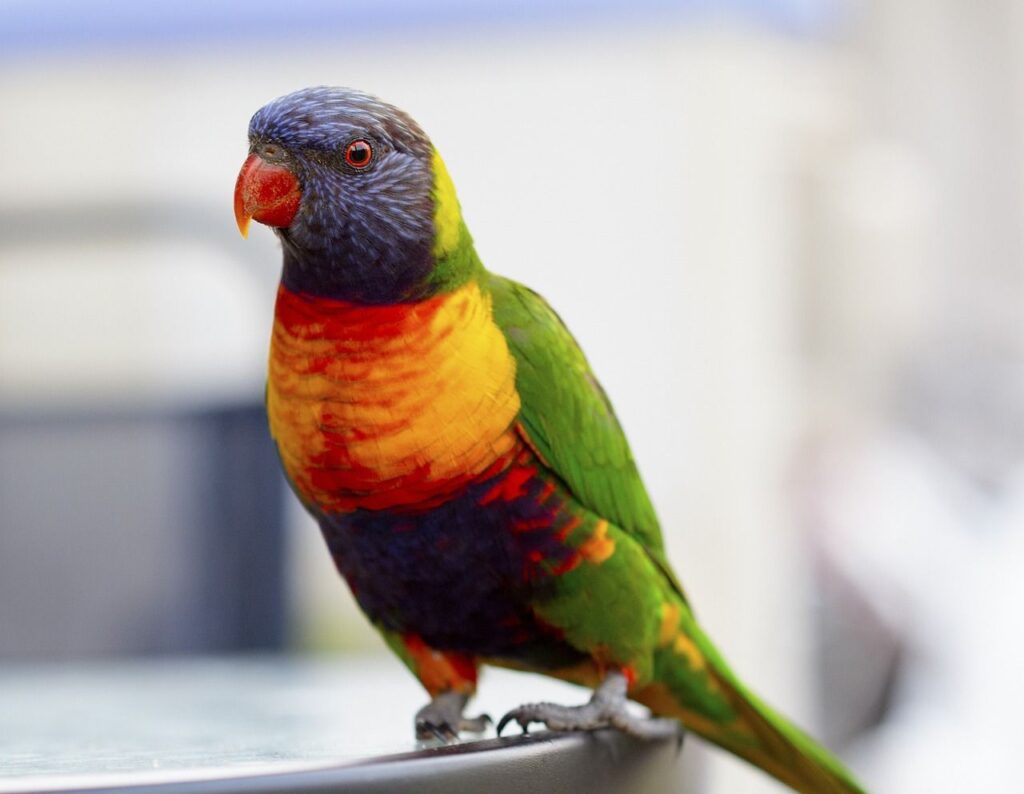
Imagine a bird that embodies the entire spectrum of a vibrant sunset. The Rainbow Lorikeet does just that, with its plumage boasting dazzling blues, emerald greens, fiery reds, and sunshine yellows. These Australian and Southeast Asian gems come in various subspecies, each sporting a unique color combination. Look for the Eastern Rosella with its crimson chest patch, the Musk Lorikeet with its vibrant green back, or the Red-collared Lorikeet, adorned with a band of scarlet around its neck.
Beyond their mesmerizing colors, Rainbow Lorikeets are known for their playful nature and acrobatic skills. They flit through treetops, their wings flashing like living jewels, and indulge in sweet treats like nectar and pollen. Their social side shines through in their flock interactions, often accompanied by cheerful chirps and whistles.
#14. Victoria’s Riflebird: A Master of Mesmerizing Dance
- Scientific Name: Ptiloris victoriae
- Habitat: Australia
- Notable Features: Vibrant black and iridescent plumage, known for elaborate courtship displays.
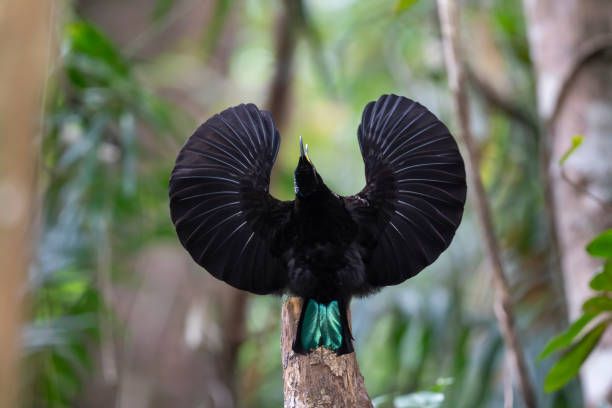
Deep in the rainforests of Australia, a dazzling black beauty named the Victoria’s Riflebird captivates with its mesmerizing courtship displays. Imagine a male, cloaked in obsidian feathers, transforming into a vibrant spectacle. His throat shield expands, displaying an electric blue shine, while elongated emerald-green plumes erupt from his head. With graceful hops and elaborate postures, he dances before his potential mate, a true master of avian theatrics.
But the magic doesn’t stop there. This bird’s name reflects the iridescent sheen of its feathers, which shimmer with shades of purple, green, and blue depending on the light. Even its call is unique, a melodic whistle that echoes through the rainforest canopy.
#13 Snowy Owl: A Ghost of the Arctic Tundra
- Scientific Name: Bubo scandiacus
- Habitat: Arctic tundra, northern regions
- Notable Features: Pure white feathers

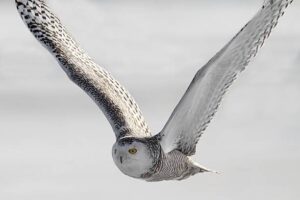

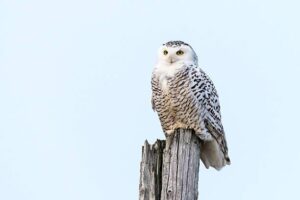
Against the stark backdrop of the Arctic tundra, a ghost-like figure reigns supreme. The Snowy Owl, draped in pure white feathers, blends seamlessly with the snow-covered landscape. This silent predator, with its piercing yellow eyes and powerful talons, is perfectly adapted to its harsh environment.
But its beauty goes beyond its camouflage. The Snowy Owl has a wingspan that can reach up to six feet, allowing for silent, powerful flight. Its keen eyesight enables it to spot prey from afar, whether it’s a lemming scurrying across the snow or a ptarmigan hidden amongst the rocks. This magnificent bird embodies the resilience and beauty of the Arctic wilderness.
#12 Atlantic Puffin (Fratercula arctica): A Charismatic Charmer of the North Atlantic
Scientific Name: Fratercula arctica
Habitat: North Atlantic, coastal cliffs, and islands
Notable Features: Distinctive orange beak, black-and-white plumage, skilled flyers and swimmers.
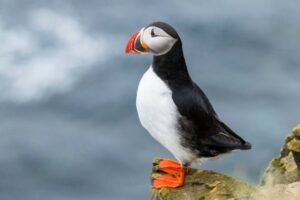


With its comical orange beak and tuxedo-like plumage, the Atlantic Puffin brings a touch of whimsy to the North Atlantic coasts. These charismatic seabirds have adapted perfectly to their island life, diving deep for fish and navigating the waves with their powerful wings.
The Puffin’s unique appearance is sure to draw attention. Its beak, brightly colored during breeding season, transforms into a “horn” used for display and courtship. Its black and white plumage provides camouflage at sea while also aiding in heat regulation. But don’t underestimate these adorable birds, they are skilled flyers and adept swimmers, making them true marvels of avian evolution.
#11 The Resplendent Quetzal: A Symbol Of Beauty In Central America
Scientific Name: Pharomachrus mocinno
Habitat: Central American rainforests
Notable Features: Vibrant green plumage, iridescent emerald crest, and a long flowing tail.


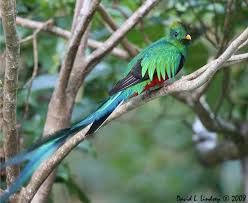

Watch and Listen
The Resplendent Quetzal, known as the “jewel of the cloud forest,” is a breathtaking bird found in the lush rainforests of Central America. Revered by ancient Mayan and Aztec civilizations, this magnificent creature has become a symbol of beauty and elegance in the region. The male Quetzal boasts vibrant green plumage, an iridescent emerald crest, and a long flowing tail that trails behind it like an ethereal ribbon.
These miniature birds have the highest metabolism of any animal, so they must consume high-energy nectar and pollen constantly to fuel their bodies. A hummingbird can visit 1,000 flowers per day and consumes up to 50% of its body weight in nectar every day. They use their long tongues to lap up the sweet nectar and also eat small insects like fruit flies, mosquitoes, and gnats.
Its striking appearance and graceful flight have captivated both locals and tourists alike. Beyond its stunning physical attributes, the Resplendent Quetzal also holds cultural significance. Considered sacred by indigenous communities, it is believed to embody wisdom, freedom, and fertility. Legends often depict this bird as a messenger between gods or even as a representation of divinity itself.
Watch
#10 Blue Jay – A Stunning Backyard Beauty
Scientific Name: Cyanocitta cristata
Habitat: North American forests and urban areas
Notable Features: Vibrant cobalt blue and white coloring, with a distinctive crest.
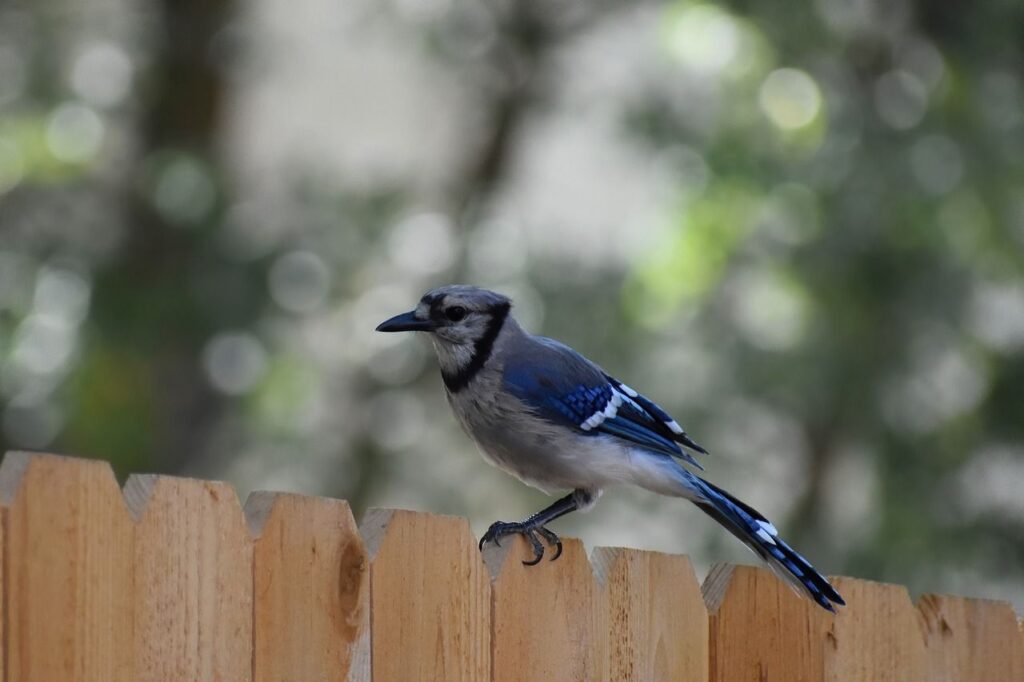
With its vibrant blue feathers and crest, the blue jay is one of the most striking birds found throughout North America. A common visitor to backyard bird feeders, the blue jay’s stunning plumage makes it a delight to spot.
You’ll recognize the blue jay by its distinctive blue and white coloring. Its back, wings and tail are a bright cobalt blue, while its underside is a lighter blue-gray. The blue jay’s most distinctive feature is its crest, which it raises and lowers depending on its mood. When the crest is raised, it appears like a blue flame atop its head.
Like many corvids, blue jays are intelligent and social birds. They travel in small family groups and use a variety of calls to communicate with each other, including a loud ‘jeer’ sound. Blue jays mostly eat nuts, acorns, and seeds, though they are omnivores and will eat insects, eggs, and nestlings as well.
Though often considered pests by other birdwatchers, the blue jay brings colour and life to yards and parks across the continent. While bold and brassy, they are striking birds that are always a delight to observe. Whether loudly calling to each other while flying between trees or squabbling at a feeder over peanuts, the blue jay’s antics are endlessly entertaining.
Despite their noisy and aggressive behavior, blue jays are endearing birds that brighten up any outdoor space. So the next time you spot that familiar flash of blue in your yard, take a moment to appreciate the beauty and wonder of the blue jay.
#9 Scarlet Macaw – A Rainbow of Colours
Scientific Name: Ara macao
Habitat: Tropical South America
Notable Features: Brilliant red, blue, and yellow plumage; known for intelligence and playfulness.
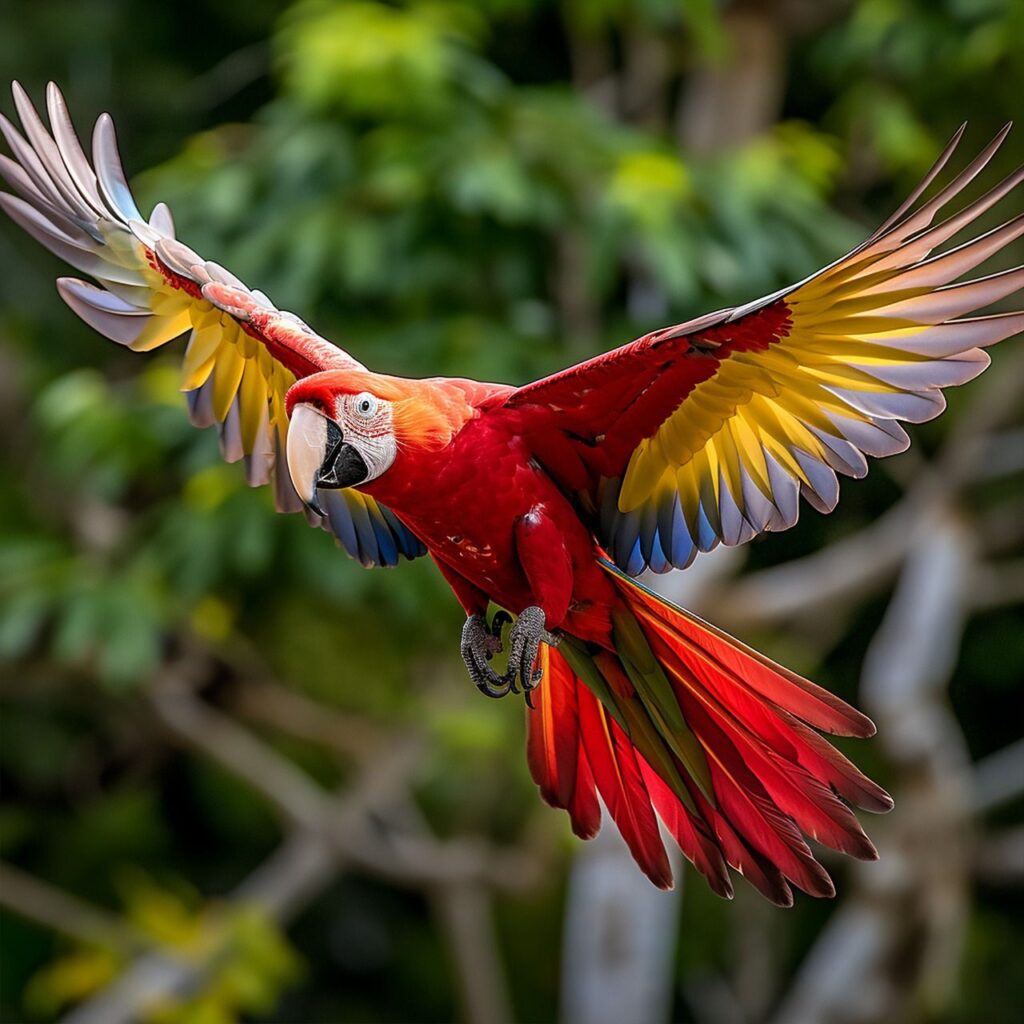
The Scarlet Macaw is one of the most stunning parrots in the world with its brilliant red, blue and yellow plumage. Native to tropical South America, this macaw can live up to 75 years and mate for life.
Scarlet Macaws are highly social and intelligent birds that can also be quite loud and boisterous at times. They are excellent talkers and have a reputation for being “clowns of the rainforest” with their playful and mischievous behavior. However, they require daily interaction, mental stimulation and a varied diet to be happy and well-adjusted.
This medium-sized macaw has a wingspan of up to 3 feet and can weigh up to 3 pounds. Its vibrant red, blue and yellow feathers are a sight to behold. Scarlet Macaws are known for their long pointed tail, bare white face and a characteristic “wrinkled” facial expression. They have a loud, raspy squawk and screech frequently while flying or interacting with each other.
Scarlet Macaws typically mate for life and the female usually lays 2-3 eggs in the hollow of a tree. The altricial chicks require constant feeding and care for several months before fledging the nest. These social birds can live up to 75 years, so they are a long-term commitment as a pet.
To care for a Scarlet Macaw, you’ll need a large cage, high-quality pelleted food, lots of toys to keep them stimulated, and several hours a day of interaction and handling. Scarlet Macaws can become quite tame and socialized if hand-fed and handled frequently from an early age. However, they are still wild animals and may bite or become aggressive if provoked. Proper training and handling is essential for these intelligent parrots.
The stunning beauty and playful nature of the Scarlet Macaw makes it a prized pet. However, their long lifespan, demanding needs, loud calls and potential aggression mean they are best suited to experienced bird owners dedicated to providing a enriching lifelong home. For the right owner, a Scarlet Macaw can make an endearing and charismatic lifelong companion.
#8 The Majestic Peacock: A Vibrant Display Of Feathers
Scientific Name: Pavo cristatus
Habitat: Indian subcontinent and Southeast Asia
Notable Features: Iridescent blue and green feathers, long elaborate tail feathers, and a vibrant display during mating.
Peacocks are known for their iridescent blue and green feathers and long, elaborate tail feathers. The males, known as peacocks, have the iconic tail feathers that they display during courtship rituals to attract mates. Females, known as peahens, have more subdued gray and brown feathers.

Peacocks are found in forests, grasslands, and scrublands of India and Sri Lanka. They tend to stay near the ground, only flying short distances when needed. By day, they forage for plants, seeds, insects, and small animals. At night, they roost high in trees.
A peacock’s tail feathers, known as coverts, make up more than 60% of its body length. When displaying for peahens during mating season, a peacock will erect and fan out its coverts into a massive, iridescent train. It will then quiver and vibrate its feathers to create a rustling sound to attract potential mates. This dazzling display highlights the peacock’s bright plumage and showcases its vigor and fitness.
Peacocks are a symbol of beauty, pride, and vanity in many cultures. Their flamboyant and colorful displays have captivated people for centuries. Once found only in Asia, peacocks now inhabit parks, estates, and farms around the world. However, some populations have declined due to habitat loss and hunting. Several conservation programs are working to protect peacocks and their native habitats.
These majestic birds never fail to mesmerize with their extravagant beauty. If you ever have the chance to see a peacock displaying in person, you’ll understand why they are considered by many to be the most beautiful birds in the world. Their dramatic and alluring shows are a sight to behold.
#7 Flamingo – Elegant in Pink Plumage
Scientific Name: Phoenicopteridae family
Habitat: Coastal regions and wetlands globally
Notable Features: Long legs, curvy neck, and distinctive pink feathers.
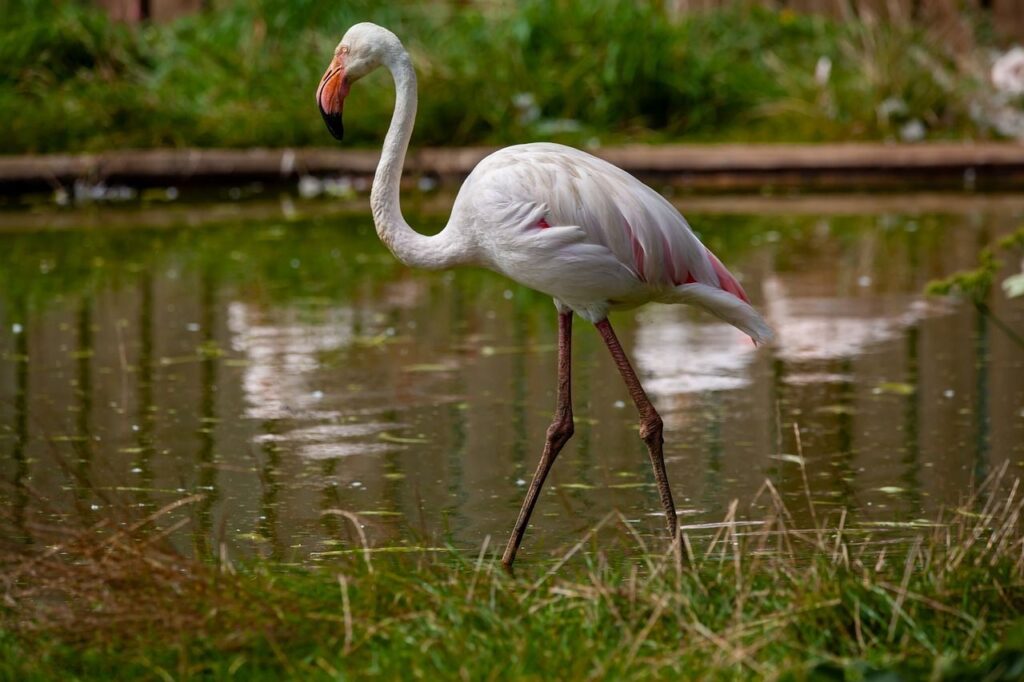
Listen Flamingo
The flamingo is one of the most recognizable birds in the world with its long legs, curvy neck, and bright pink feathers. These exotic birds inhabit warm coastal regions and wetlands across the Americas, Africa, Europe, and Asia.
Vibrant Plumage
Flamingos get their distinctive pink color from the carotenoid pigments in the algae and crustaceans they eat. The more pigments consumed, the darker and brighter their feathers become. Their feathers actually start out gray, but turn pink over time due to this diet. The color serves as a indication of health and vitality to potential mates.
These long-legged birds have an average wingspan of 3 to 5 feet, though some species can reach up to 6 feet, making them one of the largest flying birds. Their spindly legs and webbed feet are perfectly adapted for wading in shallow coastal waters and wetlands, where they feed primarily on algae, shrimp, and other small invertebrates.
Social Birds
Flamingos are very social animals and live in large colonies that can number up to several hundred thousand individuals. They are monogamous and mate for life, performing an elaborate mating dance each year to strengthen their bond and select a nesting site. The female typically lays a single egg, and both parents take turns incubating it for about a month until it hatches.
The flamingo’s bright color, unusual shape, and social nature have made it an enduring and beloved symbol of tropical beaches, resorts, and wildlife. Though still common in some areas, habitat loss and climate change pose threats to several flamingo populations. Efforts to protect wetlands and coastal environments are critical to ensuring these flamboyant birds remain a familiar sight for generations to come.
#6 The Colorful Toucan: Nature’s Living Rainbow
Scientific Name: Ramphastidae family (various species)
Habitat: Central and South American rainforests
Notable Features: Oversized, colorful bill, vibrant colors on black body (varies by species).
Look Toucan
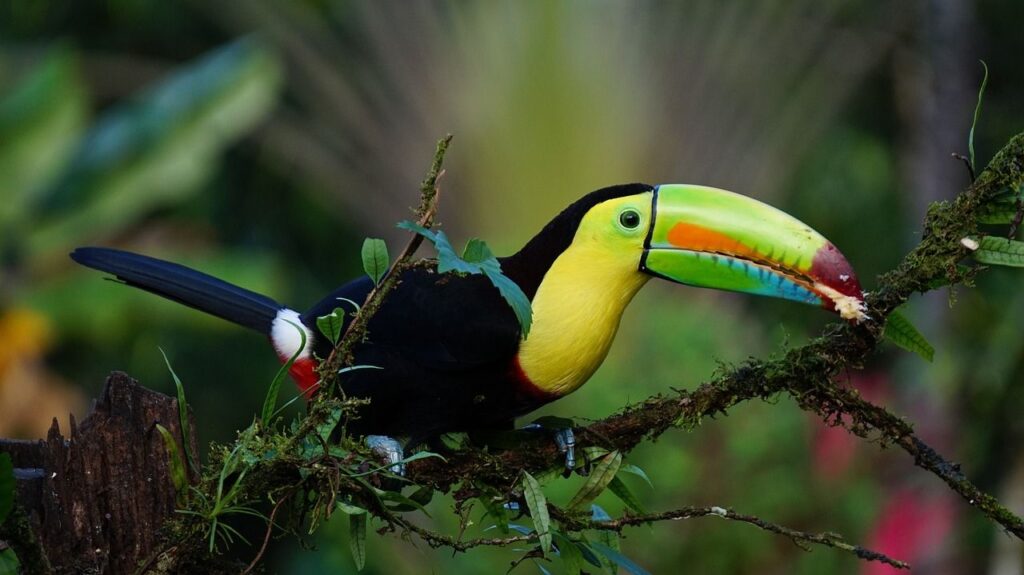
Watch Toucan
Listen Toucan
The toucan is one of the most visually striking birds in the world with its oversized, colorful bill and black body. Native to the tropical rainforests of Central and South America, the toucan is a prized member of the toucan family. With over 40 species of toucans, one of the most well-known is the colorful Toco toucan.
Toucans are aptly named for their bills, which make up nearly one third of their body length. These exaggerated beaks are very light, made of keratin, the same material as human fingernails, and are useful for peeling fruit, reaching into holes in trees, and even displaying to mates. A toucan’s bill is able to sense the ripeness of fruit and has taste buds to help select the sweetest snacks.
While toucans mainly eat fruit, they are actually omnivores. They consume insects, eggs, small reptiles, and amphibians in addition to fruit. Toucans are also accomplished fliers, gliding from tree to tree, though they do prefer to hop. Their feet have two toes facing forward and two facing backward, providing a strong grip.
The bold black and bright colors of the toucan, especially the vibrant yellows, oranges and reds of their massive bills, make them a treat for birdwatchers and nature lovers. However, their beauty has also made them targets of illegal wildlife trade. Several toucan species are endangered due to deforestation and poaching.
If you’re lucky enough to spot one of these stunning birds in the wild, you’ll be rewarded with an unforgettable sight. Their colorful plumage and oversized bills make the toucan a tropical bird like no other. Although found throughout Central and South America, encountering one in its natural habitat is a rare privilege for any avid birdwatcher or ecotourist.
#5 Hummingbird (Trochilidae)- Tiny and Dazzling
Scientific Name: Trochilidae family (over 300 species)
Habitat: Americas
Notable Features: Iridescent feathers, rapid flight, and long bills for feeding on nectar.
Look


Watch and Listen
The hummingbird is one of the smallest birds in the world, yet also one of the most dazzling. With iridescent feathers that flash brilliant colors like ruby, emerald and sapphire, hummingbirds seem to glow. Their tiny size, acrobatic flying skills and high-speed wings that flap up to 80 times per second make them a delight to watch. The hummingbird family has over 300 species, with varying sizes, colors, and bill shapes.
Hummingbirds are only found in the Western Hemisphere, from southeastern Alaska to southern Chile. The majority of species live in tropical Central and South America. Some hummingbirds migrate long distances, while others remain in the same area throughout the year. During mating season, the males perform elaborate courtship displays to attract females, diving and swooping while emitting chirps and trills.
These dazzling birds build tiny nests, usually in the fork of a tree limb, and lay eggs the size of jelly beans. A mother hummingbird incubates her eggs for about two weeks, feeding her hatchlings every 20 minutes from sunrise to sunset. Hummingbird chicks grow very fast, ready to leave the nest after only three weeks.
With their beauty, grace and intriguing behaviors, hummingbirds enchant people all over the world. Many enjoy attracting hummingbirds to their yards by planting red, pink and orange flowers and providing feeders of sugar water or commercial nectar. Watching these little sprites buzz and hover as they feed can brighten any day. Though tiny, hummingbirds have huge appeal.
#4 Bird of Paradise – Dramatic Plumes
Scientific Name: Paradisaeidae family (over 40 species)
Habitat: New Guinea and Australia
Notable Features: Elaborate courtship displays, vibrant plumage; varies by species.
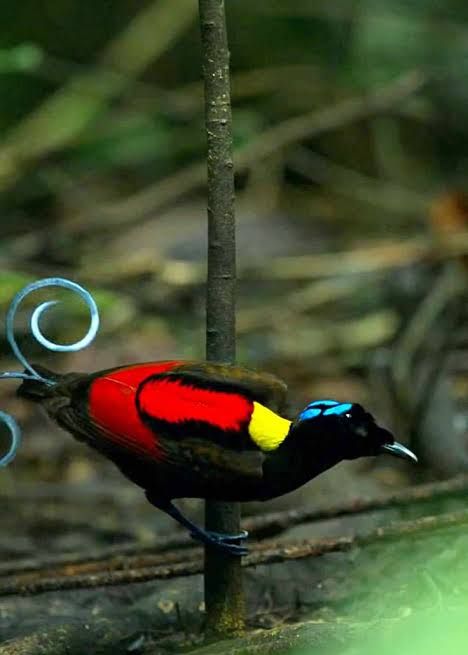
List and Watch
The aptly named Bird of Paradise is one of the most stunning birds in the world. With its vivid plumage and eccentric mating displays, this tropical bird is a sight to behold.
Found in New Guinea and parts of Australia, the male Bird of Paradise is known for its elaborate courtship rituals and brilliant plumage. The bird has distinctive orange and blue feathers, a yellow cloak, and long tail feathers that stream behind it. During mating season, the males gather in groups and perform an elaborate dance for the females, displaying their colorful plumage and making loud calls and whistles. The male hops and sways, spreading and vibrating his cape-like feathers and long tail wires to capture the female’s attention.
The Bird of Paradise favors dense rainforests and forests, where it feeds on fruits, insects, and small vertebrates. Females build a simple nest of leaves and twigs in the forest canopy, where she lays one or two eggs. The female alone incubates the eggs and cares for the young.
With over 40 different species, the Bird of Paradise has an array of sizes, colors, and mating displays. Some of the most striking are:
The King of Saxony Bird of Paradise, with two long tail feathers that can reach up to 1 meter in length.
The Superb Bird of Paradise, an iridescent blue bird with a yellow mantle and two long tail feathers.
The Twelve-Wired Bird of Paradise, with six long tail feathers and filamentous flank plumes.
The Magnificent Riflebird, a velvety black bird with iridescent green and purple feathers and a red throat wattle.
Whether you catch a glimpse of these dramatic birds in their native habitat or just see photos and videos, the Bird of Paradise is a colorful reminder of nature’s artistry and the power of natural selection. Their dazzling beauty and elaborate courtship displays highlight the wonders of evolution and the diversity of life on our planet.
#3 Hyacinth Macaw – The Largest Parrot
Scientific Name: Anodorhynchus hyacinthinus
Habitat: Central and Eastern South America
Notable Features: Cobalt-blue plumage, largest parrot species, social and intelligent.
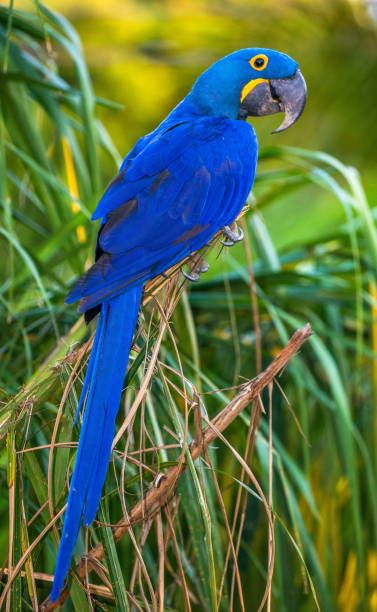
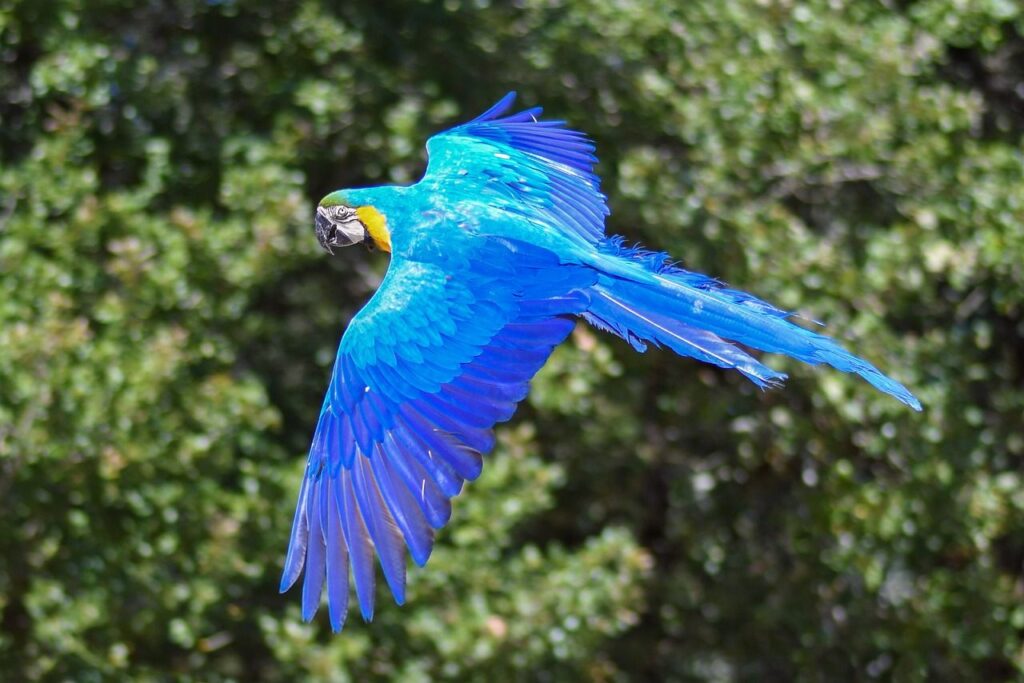
Bird’s Call
The Hyacinth Macaw is a majestic, cobalt-blue parrot that is the largest parrot in the world. Native to central and eastern South America, this magnificent bird can reach up to 40 inches in length from head to tail, with a wingspan of up to 60 inches. Due to habitat loss and poaching, the Hyacinth Macaw is currently endangered in the wild.
With radiant plumage and a powerful beak, the Hyacinth Macaw mainly eats nuts, seeds, and fruit. Their favorite food is the nut of the acuri palm, which they expertly crack open with their beak. They are also known to eat nuts, berries, and corn. These parrots are very social and mate for life, using loud screeches and squawks to communicate with each other.
Hyacinth Macaws require a serious long-term commitment as they can live upto 50 years sometimes above. Due to their size and intelligence, they need a large cage, plenty of mental stimulation, and several hours of interaction and exercise outside their cage daily. Their striking blue feathers and ability to talk have made them desirable as pets, but they can be difficult to care for properly and are not usually recommended for inexperienced owners.
Some interesting facts about the Hyacinth Macaw:
Some interesting facts about the Hyacinth Macaw:
•They are excellent fliers and can reach speeds up to 35 miles per hour.
•Females typically lay 1-2 eggs which hatch after about a month of incubation.
•In the wild, they nest high up in tree hollows, but will also use cliff crevices.
•Their tongue has a bone inside it which helps them crack open hard nuts and seeds.
•Hyacinth Macaws are highly social and form close bonds with their owners and flock mates.
With stunning beauty and intelligence, the Hyacinth Macaw is a magnificent bird that deserves respect and conservation. Although challenging to care for, they can make rewarding lifelong companions for dedicated owners. These parrots showcase the wonder and diversity of life on our planet.
#2 Royal Flycatcher – A Jewel of the Avian World
Scientific Name: Onychorhynchus coronatus
Habitat: Central and South American rainforests as far as Peru, Bolivia, Ecuador, Colombia and Venezuela
Notable Features: Regal posture and elaborate courtship displays mark the Royal Flycatcher. Brown with russet touches, these birds boast stunning fan-shaped crests: fiery red and blue for males, yellow or orange for females.


Earthy brown overall, with a bright rust-colored tail and distinctive crest. Males flaunt a regal red & blue crest, while females have a sunny yellow one, the Royal Flycatcher is truly one of the most stunning birds in the world. Found in Central and South America, Mexico, this small flycatcher makes its home in the dense tropical rainforests and woodlands.
When you spot the Royal Flycatcher, it’s hard to miss the male’s dazzling azure blue crest and russet-colored body. The female is more understated but still striking, with an olive-colored body and chestnut crest. These vivid colors and the bird’s regal posture are how it earned the name “Royal” Flycatcher.
Like its relatives the tyrannids, the Royal Flycatcher feeds primarily on insects it catches in mid-air or gleans from foliage. It perches silently on a branch, then darts out suddenly to snatch its prey before returning to its perch. Its diet consists mainly of beetles, grasshoppers, flies, and other small insects.
During the breeding season, the male Royal Flycatcher puts on an impressive display to attract a mate. He raises his brilliant blue crest, fluffs his feathers, and vocalizes a series of whistles and harsh calls. Once paired, the female builds a cup-shaped nest in a tree hollow or similar crevice and lays two to four eggs. Both parents share in incubating the eggs and feeding the chicks.
Sadly, the Royal Flycatcher’s population has declined in recent years due to deforestation and habitat loss. However, it is still commonly seen in many protected areas throughout its range. If we make conservation of tropical rainforests a priority, these jewel-like flycatchers will hopefully continue to dazzle us for generations to come.
The striking Royal Flycatcher, with its vivid plumage and interesting behaviors, proves that some of the most beautiful things in nature come in small packages. This pint-sized bird is truly a visual wonder and an avian treasure worth protecting.
#1 Peacock Pheasant – The Most Beautiful Bird in the World
Scientific Name: Polyplectron germaini
Habitat: Southeast Asia
Notable Features: Iridescent blue-green feathers, long tail, and distinctive purple crest, 8 species


The Peacock Pheasant is considered by many to be the most beautiful bird in the world due to its extravagant plumage. You’ll find this stunning bird in southern Indochina. It is found in the seasonal tropical forests of mid-southern Vietnam and far eastern Cambodia; it can be found readily in Cat Tien National Park. It consisting of eight species.
With iridescent blue-green feathers, a long tail and a distinctive purple crest, the male Peacock Pheasant, in particular, is a sight to behold. His dazzling display of feathers is meant to attract females during the breeding season. The peacock pheasant has a metallic sheen to its feathers unlike most birds. As the light hits its feathers, you’ll see an array of colors – turquoise, emerald and sapphire. The female, on the other hand, has dull brown plumage which allows her to camouflage while nesting.
These pheasants tend to be solitary or found in small groups foraging on the forest floor for seeds, berries, and invertebrates. Due to deforestation and poaching, peacock pheasant populations have declined dramatically. They are currently listed as near threatened by the IUCN. If you’re lucky enough to spot one in the wild, cherish the moment and appreciate the natural beauty of this exotic bird.
Some other characteristics of the Peacock Pheasant:
- Males can grow up to 24 inches in length, while females reach about 20 inches.
- Their calls are loud, harsh crowing sounds.
- The female usually lays two eggs.
Whether you see one in a nature documentary, at a zoo, or are extremely fortunate to spot one in the wild, the Peacock Pheasant is a spectacular bird that showcases the wonder of nature. Its dazzling display of colors and plumage is unparalleled in the avian world.
Conclusion
So there you have it – 10 of the most beautiful birds in the world. From the flashy plumage of the peacock to the iridescent feathers of the hummingbird, each one is stunning in its own way. When you come across these feathered creatures in your travels, take a moment to appreciate the artistry of nature. Their vibrant colors and elaborate designs didn’t just happen by chance – they are the result of eons of adaptation and evolution. Next time you hear a beautiful birdsong or spot a flash of color taking wing, consider yourself lucky to witness such natural beauty. Our world is filled with avian eye candy if you know where to look! Now get out there and do some birdwatching – you never know what beauty you might see.










